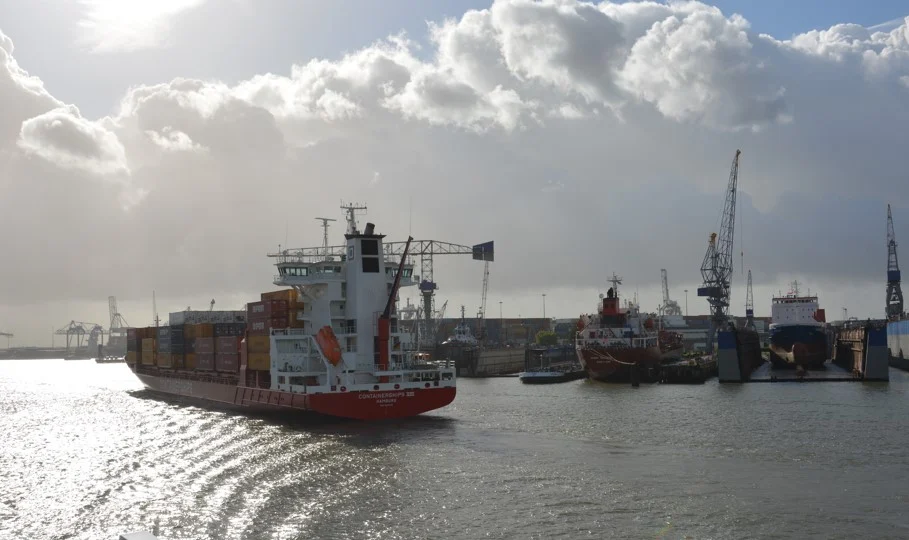The adoption of hydrogen as marine fuel for deep sea-going vessels seems to be lagging behind its counterparts such as methanol and ammonia. Hydrogen is an attractive fuel for internal combustion engines and its combustion produces no greenhouse gas emissions. However, hydrogen needs to be compressed (700 bar) or liquified (-253 °C), which requires substantial ingenuity from the engineering side to enable a vessel to store the chemical element safely at such low temperatures while keeping the structural integrity of the tanks and the entire vessel intact.
As the global steel industry moves to switch to direct reduced iron (DRI) production and use green hydrogen to reduce emissions, the MENA region is in a prime position to start producing carbon-neutral or green steel, the report finds. The International Energy Agency (IEA) in its Net Zero Emissions scenario models the global share of hydrogen-based (H2) DRI-EAF production to reach 29% of primary steelmaking by 2050. BloombergNEF estimates that 56% (840 million tons) of primary steel production will come from H2DRI-EAF by 2050 in a net-zero emissions scenario.
KBR to study green ammonia-based power systems for drilling units: US engineering company KBR will conduct a study to develop a carbon-neutral, green ammonia-based power system for a semi-submersible drilling unit owned by Odfjell. As part of the study, KBR will collaborate will Odfjell, Equinor , and Wärtsilä to assess the conversion of the diesel generators onboard drilling units to ammonia-fueled generators. KBR, an ammonia licensor, is using K-GreeN technology to produce carbon-free ammonia based on the electrolysis of water.
Biofuels
Maersk supply’s fleet starts using biofuel offering carbon savings: Maersk Supply Service is becoming one of the first shipping companies to provide customers with the option to reduce carbon emissions by selecting a biofuel alternative. After extensive testing by many leading shipping companies, an increasing number are beginning to adopt biofuels as a near-term, easy-to-adopt alternative to reduce carbon emissions. Maersk Supply Service reports that in 2021 they successfully trialed biofuel aboard the anchor handler Maersk Tender. The vessel was operating in partnership with the Dutch green-tech start-up, The Ocean Cleanup.
Ports
Partners eye open-access green ammonia import terminal at Port of Antwerp-Bruges: Belgian energy infrastructure firm Fluxys has teamed up with compatriot Advario Stolthaven Antwerp and Advario Gas Terminal to study the feasibility of building an open-access green ammonia import terminal at the Port of Antwerp-Bruges. The three companies plan to combine their expertise in logistics, storage, and pipeline transmissions to ascertain the optimum ammonia storage solution for northwest Europe as the need for importing and storing green energy grows amid the decarbonization drive across Europe.
Located at Belgium’s Port of Antwerp-Bruges, the future terminal is expected to be operational in 2027. It will deliver storage and multimodal logistics solutions for ammonia (train, truck, barge, and possibly ammonia pipelines connected to local industrial sites).
 Port Houston, Shell set sights on decarbonizing the port’s container terminals:
Port Houston, Shell set sights on decarbonizing the port’s container terminals: Port Houston has signed a Memorandum of Understanding (MOU) with Shell to explore key energy, mobility, and decarbonization projects. The agreement aims to identify new technology and infrastructure opportunities at the port’s terminals that have the potential to ultimately lead to significant emissions reductions. The first project planned under the MOU will be a study to understand the decarbonization potential at Port Houston’s two container terminals, Barbours Cut Container Terminal and Bayport Container Terminal.

Regulations
Minneapolis passes Ship It Zero resolution: The Minneapolis City Council unanimously passed a Ship It Zero resolution that calls on top maritime import polluters to the US to commit to making all imports to the country on 100% zero-emission ships by 2030. Minneapolis is the third US city to pass a Ship It Zero resolution, following Los Angeles and Long Beach, California. The three cities have called on companies including Target, Walmart, Amazon, and IKEA, to immediately adopt emission-reducing technologies, such as wind-assist propulsion, and fully move products off fossil-fueled ships by the end of the decade.
The Minneapolis resolution further calls for state and federal legislation or administrative actions to rapidly decarbonize the maritime shipping industry and create zero-emission shipping corridors along the US coast and across the trans-Pacific trade route, building off the recently announced Shanghai, Los Angeles, and Long Beach green shipping corridor.
EU launches €5 billion call to make transport energy efficient: The European Commission (EC) has launched a call for proposals under the Connecting Europe Facility (CEF) for Transport program which makes available over €5 billion for European transport infrastructure projects.
The funding — €5.12 billion — will support projects across all EU Member States along the Trans-European Transport Network (TEN-T) – the network of rail, inland waterways, ports, and roads that connects Europe.
As explained, projects funded under this call will help increase the sustainability of the transport network, putting the EU on track to meet the European Green Deal objective of cutting transport emissions by 90% by 2050.













 Ningbo Containerized Freight Index Weekly Commentar
Ningbo Containerized Freight Index Weekly Commentar  Ningbo Containerized Freight Index Weekly Commentar
Ningbo Containerized Freight Index Weekly Commentar  Ningbo Containerized Freight Index Weekly Commentar
Ningbo Containerized Freight Index Weekly Commentar  BIMCO Shipping Number of the Week: Bulker newbuildi
BIMCO Shipping Number of the Week: Bulker newbuildi  Ningbo Containerized Freight Index Weekly Commentar
Ningbo Containerized Freight Index Weekly Commentar  Ningbo Containerized Freight Index Weekly Commentar
Ningbo Containerized Freight Index Weekly Commentar